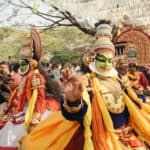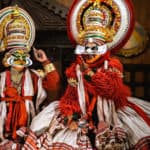The dance of Kathakali is a fusion of “dance as well as drama”. Kathakali, a classical dance style originating from India is a “Drama” centric dance form that developed in the state of Kerala, commonly referred to as ‘God’s own land‘. The Kathakali dance style essentially entails use of makeup, face masks, and heavy costumes. In addition, the unique feature of this Indian classical dance style is the fact that it also consists of elements related to “South Indian martial arts”. Furthermore, the core of this form of dancing lies in the narrating of popular mythological folklores using facial expression especially via the use of eyes.
a. History and the origin of Kathakali Dance
Even though this dance form is said to have come into existence around the 17th century, there is still no clarity about its origins. Apparently, a few historical facts suggest that this dance form is about 500-years-old. In addition, Kathakali is also said to possess the elements of Indian classical dancing mentioned in the renowned Sanskrit treatise “Natya Shastra”. These elements include use of the rasa, use of the bhava, as well as use of expression and acting techniques. Furthermore, a few scholars have also found similarities between Kathakali and other southern Indian dance styles such as Kuttiyattam and Krishnanattam.
b. Costumes used in Kathakali Dance
The costume used by a Kathakali artist is considered to be extremely “elaborate” which includes the use of heavy makeup, and face mask and headgear. It is also said that it takes at least a couple of hours for a performer to put on his complete makeup and costume. The makeup of this dance form essentially comprises of what is commonly referred to as a “colour code”. Now each of these so called colour codes represents a particular mythological character and its corresponding emotion.
For example the colour code red represents “evil” as seen in mythological characters such as Ravana, Dushasana etc. On the other hand, the colour code yellow represents monks as well as female characters possessing good virtues such as Sita, Draupadi and others. It is this unique coding system that then enables an audience to understand this dance form in its entirety. Furthermore, the face mask and headgear also helps in bringing to life the character being performed by the artist.
c. Music used during the Kathakali performance
A Kathakali performance involves the reciting of mythological verses, and hence the use of a good vocalist is required. In addition, the use of a good voice helps the performer (dancer) to convey the emotions of the character played by the performer to the audience. So for example, to express the emotion “anger” the vocalist will sing at an extremely high pitch, thereby indicating to the dancer to perform accordingly. As for musical instruments, the Maddalam (barrel shaped), Centa (cylindrical drum with curved sticks), and Itaykka (hourglass shaped drum) are commonly used during the performance.
d. Training and dancing techniques
In terms of the dance techniques, since this dance form involves elements of acting as well as dancing it is said to be extremely difficult to perform live on stage. The performer essentially has to express through facial expressions (Navarasas) and hand gestures (mudras) according to the mood created by the music. There are in all a total of 24 major mudras (i.e. hand gestures) and nine Navarasas (i.e. facial expression) that a performer has to master while studying this dance form. As for training centres, there are number of schools throughout the state that provide for proper guidance. Furthermore, admission into such centres will largely depend upon factors such as the level of physical fitness, flexibility, sense of rhythm, and performance in a personal interview by the interested candidate.



